Office of Research & Development |
 |

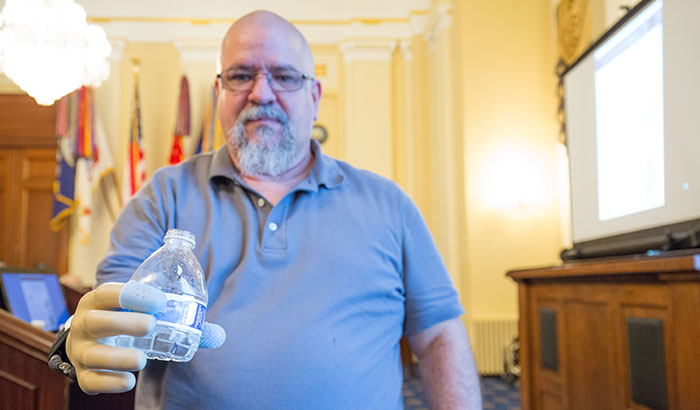
Research participant Keith Vonderhuevel demonstrated a prototype artificial hand, featuring a sense of touch, at a 2017 Capitol Hill event sponsored by Friends of VA Medical Care and Health Research. (Photo by Eugene Russell)
February 28, 2019
By Mike Richman
VA Research Communications
"I'm not as cautious when shaking a person's hand because I can feel how hard I'm squeezing it."
Artificial hands have come a long way since the days of the simple mechanical hook. Nearly 50 years ago, at a time when engineers were only dreaming of what is possible today, VA prosthetics expert Dr. Eugene Murphy wrote: “Though engineers and prosthetists have made substantial contributions, they need perspective and humility to inspire and guide the very long, sustained efforts required to replace even a few of the roles of the hand.”
Fast-forward a half-century, and today devices like the LUKE arm (formerly known as the DEKA arm), developed in part through VA research, feature hands that do in fact replace many roles of their natural counterparts. They boast features like multiple degrees of freedom, pre-programmed multiple grip patterns, and grip-force sensors. In 2018, an Air Force Veteran using the technology, Ron Currier, said at a news conference, “I feel like I have my hands back again.”
Even with all the progress in prosthetic hands, some features have remained a challenge. One is restoring a natural sense of touch to users. This has largely to do with somatosensory functions, part of the nervous system that gives us the perception of touch, pressure, pain, temperature, position, movement, and vibration. Somatosensory feedback of the hand is key to gaining a feel for objects.
That’s why Veterans and others with upper-limb protheses often struggle to determine the size of an object in their prosthetic hand and the amount of pressure to put on it.
VA researchers and collaborators have been drawing closer to this goal. One leading site is the lab of Dr. Dustin Tyler, a biomedical engineer and a principal investigator with VA’s Advanced Platform Technology Center in Cleveland. A team there carried out a trial of a technology that has been in development in recent years. The team tested the potential of artificial sensory feedback to restore lost feeling in two people with prostheses, one that starts at the wrist and the other in the forearm. The ultimate goal was to improve the ability of amputees to function normally at home, work, and in the community.
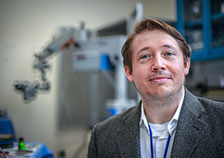
Dr. Matthew Schiefer, a biomedical engineer, was formerly with VA's Advanced Platform Technology Center in Cleveland. Today he's with the Brain Rehabilitation Research Center at the Malcolm Randall VA in Gainesville Florida. (Photo by Dan Henry)
Dr. Matthew Schiefer, formerly with the Advanced Platform Technology Center, led the trial, published in December 2018 in the online journal PLoS One. His research focuses on neural engineering, a sub-field of biomedical engineering that’s based on understanding nerve response. He hoped that through electrical nerve stimulation, the amputees would regain a sense of touch so they could determine the size and hardness of foam blocks.
The researchers concluded that artificial sensory feedback greatly improved the ability of the two participants to identify the size and hardness of the blocks. The participants identified the objects correctly about 75 percent of the time.
Schiefer transitioned last year to the Malcolm Randall VA in Gainesville Florida, after working for nearly a decade in Tyler’s lab. His Gainesville lab is part of the Brain Rehabilitation Research Center, which works to find treatments that will lead to recovery of function after neurologic disease or injury.
In the foam-block trial, he added to Tyler’s research by exploring the ability of amputees with a prosthetic hand to identify objects while blindfolded.
“Dr. Tyler’s research has focused on restoring sensation in people with an upper-limb amputation by stimulating nerves,” Schiefer says. “That’s a sensory outcome. He’s restoring sensation. His research was an ideal fit for me. The individual question I focused on was more of a functional one.“
In the foam block trial, the participants received two forms of sensory feedback—tactile and proprioceptive. Tactile refers to a sense of touch, essentially letting someone know how much pressure to apply on an object. Proprioception is the perception of the position of the missing hand. Aperture, which in this case refers to the opening and closing of the hand, or how close the fingertips are to the tip of the thumb, can produce a sense of proprioception.
To produce a sensation in the missing hand, the researchers surgically implanted nerve cuff electrodes, which are partly designed to stimulate nerves, in the non-amputated part of the arm. Wires connected to the nerve cuffs were plugged into a stimulator. Sensors mounted on the tips of the index finger, thumb, and middle finger of the artificial hand measured fingertip pressure. A sensor on the back of the prosthetic hand measured aperture when the participants squeezed the foam blocks.
The test included four sensory restoration schemes: no restored sensation, restored pressure sensation, restored proprioception sensation, and a combination of restored pressure and proprioception sensation. Based on the amount of sensation, the two participants were asked to identify whether the foam blocks were small, medium, or large, and whether they were soft, medium, or hard.
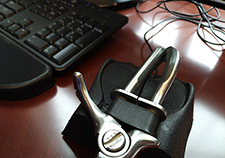
VA engineering research center posts another invention: prosthetic hook mouse
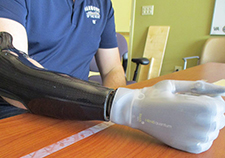
VA scientists testing new technology to absorb moisture, increase comfort with prostheses
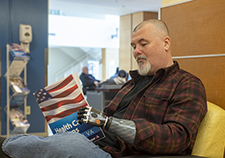
Study probes user satisfaction with upper-limb prostheses
The participants, one of whom is a Veteran, wore blindfolds and noise-canceling headphones. They told the researchers which foam block they thought was in their prosthetic hand.
“Feedback type significantly affected the amount of correct identifications,” the researchers write. “Both subjects performed best when both forms of feedback were provided and worst when no sensory feedback was provided. In general, when provided with only one form of feedback, both subjects performed better with aperture feedback. Subjects applied less pressure to the objects when they had tactile pressure feedback.”
The researchers add, “We believe this test provides an effective means to assess the impact of sensory restoration and the relative contribution of different forms of feedback in the field of neurorehabilitation—tactile versus kinesthetic.” Kinesthetic relates to a person’s awareness of the movement of body parts by means of organs in the muscles and joints.
“Less pressure is good in this case because it suggests that the subjects had more control over how hard they were grasping the objects with their prosthesis,” Schiefer says. “When the subjects had tactile feedback, they applied less pressure to the objects than when they didn’t have tactile feedback. This is important when someone is manipulating a fragile object or touching another person with a prosthetic hand. If they apply too much pressure in these situations, they could break the fragile object or hurt the other person.”
Schiefer was surprised by the accuracy of the participants in identifying the foam blocks.
“I anticipated that subject confidence would simply increase with sensory feedback,” he says. “But the fact that confidence increased with greater accuracy is remarkable because we never told the participants if they were correctly identifying the objects while undergoing the test. This suggests that the participants had a sense of their performance even without feedback from the research team.”
The study differed from Schiefer’s prior work on sensory feedback in Dustin Tyler’s lab. Previously, he and his colleagues tested whether blindfolded amputees with upper-limb prostheses could determine if wooden blocks of identical size were in their prosthetic hand, and if they could remove metal blocks from a magnetic table.
The foam block trial took the research to the next level.
“We thought, 'Okay, if we can get them to identify, locate, and examine these harder objects, what happens if we make this task more difficult and go with compressible objects?” Schiefer says. “Could the participants identify what they were feeling with their prosthetic hand while they were blindfolded, given the sensory restoration they were getting? That sensation was determined by the amount of pressure they put on the block as they examined it with their prosthetic hand.”
The researchers didn’t help the participants answer correctly by providing a pattern of sensation that they could memorize, an approach taken in some other studies, he notes.
“By that, I mean the large block didn’t produce sensation on the thumb while the small block produced sensation on the index finger,” he says. “Instead, the sensations produced by each object occurred at all four sensory locations, regardless of the object. What changed between objects was the intensity of the sensation based on the participant’s control of the electrical stimulator. This starts to approach a more natural or physiologically relevant form of sensation.”
Keith Vonderhuevel, the Veteran in the study, lost part of his right arm in an industrial accident in 2005. In the trial, he says he controlled the level of sensation by how hard he squeezed on the foam blocks. The strength or weakness of the sensation allowed him to gain a feel for the size and hardness of the blocks, he notes. He felt that the sensation would be too strong if he squeezed too tight, alerting him to back off a bit.
In recent months, Vonderhuevel has used the technology at home. He says things are coming more instinctively to him because he can feel the sensation. He knows, for example, how hard he’s touching his grandkids, how hard he’s holding an egg that he’s cracking open, and how hard he’s squeezing a sandwich.
“I’m not as cautious when shaking a person’s hand because I can feel how hard I’m squeezing it,” he says. “I don’t have to focus as much on it. Without sensation, I have to watch that I don’t squeeze too tight. You still watch a little with the sensation. But I don’t have to watch as closely because the sensation lets me know how hard I’m grabbing something.”
The trial showcased just one way artificial nerve stimulation can restore sensation for amputees with prostheses.
A technique called targeted sensory reinnervation involves surgically removing a nerve from another location in the body to stimulate a different area. For example, healthy nerves that originally carried sensory information from the hand can be re-routed to the chest. Light pressure applied to the chest may then be perceived as occurring in the hand. The approach requires surgery and specialized equipment, such as a series of tiny devices that vibrate, to apply pressure in the correct locations of the areas with new nerves. The mechanical setup would be driven by signals from the prosthetic hand, much like the electrical stimulator that was used in the foam block study.
VA researchers, including Dr. Paul Marasco of the Advanced Platform Technology Center, have studied targeted sensory reinnervation.
Schiefer believes artificial sensory feedback may someday benefit lower-limb amputees, as well. He points to an ongoing study being led by Dr. Ronald Triolo, a biomedical engineer in the Advanced Platform Technology Center, to restore natural sensation for lower-limb amputees in cases of foot-floor contact.
Triolo is exploring a system of external and implanted components that communicate wirelessly to acquire information from sensors. The sensors, which are integrated into a lower-limb prosthesis, translate the information into patterns of electrical stimulation in sensory nerves that are left in the existing limb. The goal is to help users maintain balance and navigate complex areas without the fear of falling.
“What would be useful is if lower-limb amputees were better able to walk over uneven surfaces or even detect when the prosthetic foot comes in contact with a surface,” Schiefer says. “That becomes very important on stairs and slopes.”
Tyler’s electrical nerve interface is also experimental. It’s available only under the U.S. Food and Drug Administration’s investigational device exemption clause, which allows an item to be used in a clinical study in order to produce data on its safety and effectiveness. Tyler is planning a randomized controlled trial in which upper-limb amputees will use sensory feedback in their prosthesis for several months at home. The researchers will compare patient outcomes with and without sensory feedback.
“To prepare for this trial, Dr. Tyler is developing a technology that can be entirely implanted within the body, including the electrodes, lead wires, and nerve stimulator,” Schiefer says. “These systems will communicate wirelessly with sensors in the prosthetic hand. Once the technology is ready, he’ll conduct a randomized controlled trial.”
Keith Vonderhuevel hopes to experiment with the implanted system.
“They know I want to use it because I keep bugging them about it,” he says. “They want a new test subject to be the first person. Hopefully, I’ll be the second person because I’ve got the first system they put in. They’ll have to go in and remove that system and let me heal for a few months, then go back and implant the new system. I’m ready when they are.”
VA Research Currents archives || Sign up for VA Research updates